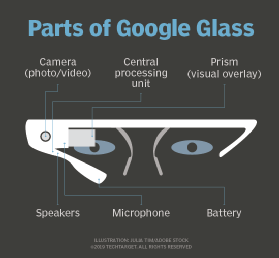Google Glass
Google Glass is a wearable, voice- and motion-controlled Android device that resembles a pair of eyeglasses and displays information directly in the user's field of vision.
Google Glass offers an augmented reality experience by using visual, audio and location-based inputs to provide relevant information. For example, upon entering an airport, a user could automatically receive flight status information.
When the first version was launched in 2013, consumers immediately voiced their concern of the glasses being an invasion of privacy. Google Glass represented inescapable recording in everyday life. At first, Google attempted to rebrand the glasses as a tool for professionals such as surgeons or factory workers. However, concern remained and Google ceased all work on the Glass project in 2015.
In 2017 work resumed with Glass Enterprise Edition. This relaunch of the project focused all efforts on making a product that would benefit workplaces like factories and warehouses. In 2019, a new version of Google Glass was released -- the Glass Enterprise Edition 2.
How Google Glasses work
The Google Glass operating system (OS) is based on a version of Android. The OS can run application virtualization tools called Glassware that are optimized for the device. Glassware allows the device to deliver an app to the user, instead of a full desktop. The glasses have built-in Wi-Fi and Bluetooth connectivity and a camera for taking photographs and videos.
The smart eyewear uses motion and voice recognition to process commands from the wearer. A touchpad is also available on the glasses' rim. To provide the requested information, the device relies on sending small packages of information straight to the wearer through a micro-projector, using a private channel of communication that can only be accessed by the user.
Google Glass then uses a field sequential color (FSC) liquid crystal on silicon (LCOS) system to display images on the lens, allowing wearers to view the image in true colors. FSC refers to a color television system that transmits the primary color information in continuous images and then relies on the human's vision and perception to collect the information into a color picture. LCOS is a form of video display technology.
Features of Google Glass
The key feature of Google Glass is the tiny semi-transparent screen located on the upper right hand side of the glasses. This display occupies only about 5 percent of the wearer's natural field of vision and is responsible for transmitting information to the user.
In order to view the screen, wearers must look up, placing the screen out of the direct line of vision. This feature is particularly important because bad placement of the display could lead to serious safety issues.
Other features of Google Glass include:
- The ability to take photos and videos and then share exactly what the user is seeing through Google Hangouts.
- The option to use the Google search engine through the glasses, using Wi-Fi or a smartphone's data connection.
- The ability to have translations streamed straight to the wearer through the screen.
- Reminders to complete certain chores or tasks with an added visual aspect that will prompt a notification to appear on the user's screen every time they look at a particular object.
- The ability to sync the glasses to calendars stored on phones or computers in order to receive reminders of events and meetings.
- Support of both voice and video calls. In the video calls, wearers can show the other person exactly what they're looking at instead of talking face-to-face.
- The ability to answer emails and text messages using voice dictation.
- Collaboration with Google Maps to provide step-by-step directions with a map displayed on the screen.
- The ability to respond to facial and head movements, such as allowing the user to tilt their head to scroll through a page or operate the device with eye movements.

Benefits of Google Glass
The most recent edition of Google Glass, Glass Enterprise Edition 2, is designed specifically for professional use, especially in environments such as factories, warehouses and hospitals. In these settings, the glasses provide the benefit of saving time and money and increasing safety.
Workers' safety is improved by the hands free feature and ability to stay connected to the network at all times.
Another benefit is the fact that the head mounted display is always accessible in the user's field of vision. Therefore, wearers can receive and send information and notifications without having to physically check a smartphone or mobile device.
The potential use of Google Glass by children with autism is another benefit of the device. Various studies are researching how Google Glass might be used to improve social interactions for kids with autism.
Glass Enterprise Edition 2
The newest version of Google Glass, Glass Enterprise Edition 2, features a USB-C port for faster charging, an improved camera and a processing boost from its new use of Qualcomm's Snapdragon XR1 chip, which is designed specifically for augmented and virtual reality systems. The XR1 chip allows the Google Glass device to integrate advanced machine learning and computer vision abilities.
Safety frames have been added to the design, making the glasses more effective and compatible in diverse work environments. Other improvements include a bigger battery that provides longer battery life, upgraded Wi-Fi and Bluetooth connections and support of Android Enterprise mobile device management.
Since releasing Edition 2, Google has been working on a third version of the smart eyewear.








